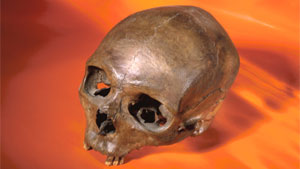
At a press conference yesterday, researchers announced the completely unexpected: a Siberian cave has yielded evidence of an entirely unknown human relative that appears to have shared Asia with both modern humans and Neanderthals less than 50,000 years ago. The find comes courtesy of a single bone from individual’s hand. Lest you think that paleontologists are overinterpreting a tiny fragment, it wasn’t the shape of the bone that indicates the presence of a new species—it was the DNA that it contained.
The paper that describes the finding comes courtesy of the Max Planck Institute’s Svante Pääbo, who has been actively pursuing the sequencing of the Neanderthal genome. It seems likely that this particular bone fragment was targeted due to suspicions that it might also provide an additional Neanderthal sequence. The site, called Denisova, is in the Altai Mountains of southern Siberia, an area that has had hominins present as early as 125,000 years ago. The sample itself came from a layer of material that dates from between 30,000 and 50,000 years ago. Neanderthal DNA was found in a sample from the same time period less than 100km away, while artifacts indicate that modern humans were also present in the region by 40,000 years ago.
So, there was no apparent reason to suspect that the bone would yield anything more than a familiar sequence. And in fact, most of the first half of the paper simply describes the methods used to construct a complete sequence of the mitochondrial DNA, including over 150-fold coverage of the genome, and an alignment program designed to account for the errors typical of ancient DNA sequences. About the only surprise here is that Pääbo’s group has switched from using 454 sequencing machines to those made by Illumina.
Various checks indicate that the sequence the authors obtained contains damage that’s typical of ancient DNA, and that it all comes from a single individual. So far, quite typical.
Things got quite unusual when they attempted to align the sequence to the mitochondrial DNA from the hominin species that were likely to be present at that time and place: human and Neanderthal. Instead of clustering with one or the other, the Denisova mitochondrial genome was a clear outlier, having about 385 differences with the typical human mitochondrial genome. In contrast, Neanderthals only differ from modern humans by an average of 202. The obvious interpretation is that the Denisova lineage split off before modern humans and Neanderthals did. If we accept that Neanderthals are a distinct species of hominin (and we do), then this sample clearly represents yet another one.
Building a tree with the chimpanzee genomes and assuming a divergence time of 6 million years, the data indicates that the Denisova lineage diverged about a million years ago. At that point, Homo Erectus was already a global species, but our human ancestors were still in Africa. That suggests that the Denisova variant probably originated in, or at least near, Africa as well, although there’s no way to tell whether it was a distinct species before it started migrating, or whether it became an isolated population because of a migration.
The paper is in the format of a Nature letter, which allows only a paragraph for discussion. The authors use that space primarily to note that, 40,000 years ago, southern Siberia was a very busy place as far as hominins are concerned, with at least three different species present within a very narrow time frame. If we accept that the Indonesian hobbits are yet another distinct species—and the relevant community seems to be leaning that way—then it appears that there were at least four distinct hominin species cohabiting the globe in the very recent past.
As surprising as that is, it’s only a small fraction of the implications of this work. For starters, there’s the whole idea that we can identify a new species without having any idea what it actually looked like—in fact, without having any idea of whether it would be physically distinct enough from any of the other hominin species around that we’d even have known it were a separate species based on the bones.
The authors also briefly touched on a separate issue: this ability will be unevenly distributed in space and time. DNA simply lasts longer in cool climates, as evidenced by the recent announcement that DNA had been obtained from a polar bear sample that was over 100,000 years old. So, any species that was stuck near the equator—like the hobbits—are unlikely to be in on the DNA revolution. This is especially unfortunate given the fact that, as noted above, a lot of the most interesting action in hominin origins seem to have been taking place in Africa.
Then there’s the whole question of what else we might be missing. Avoiding contamination issues with modern DNA is easiest if the entire excavation is designed around a sterile technique from the start, meaning bones that have been previously excavated aren’t ideal. At the moment, at least, sequencing from a single sample is also pretty labor intensive (this paper had seven authors), meaning we aren’t likely to be able to just start sequencing any bone fragments we stumble across. Figuring out how to prioritize what might be informative will be a real challenge.
If that seems like a lot of questions for a short and fairly technical paper (and it is), it’s a product of the fact that this paper seems truly exceptional. Because of the rich history of most fields of science, there aren’t a whole lot of truly unexpected results, since you typically know that there are people working in a given area. But this finding is truly a stunning one, and really seems to be a complete surprise.